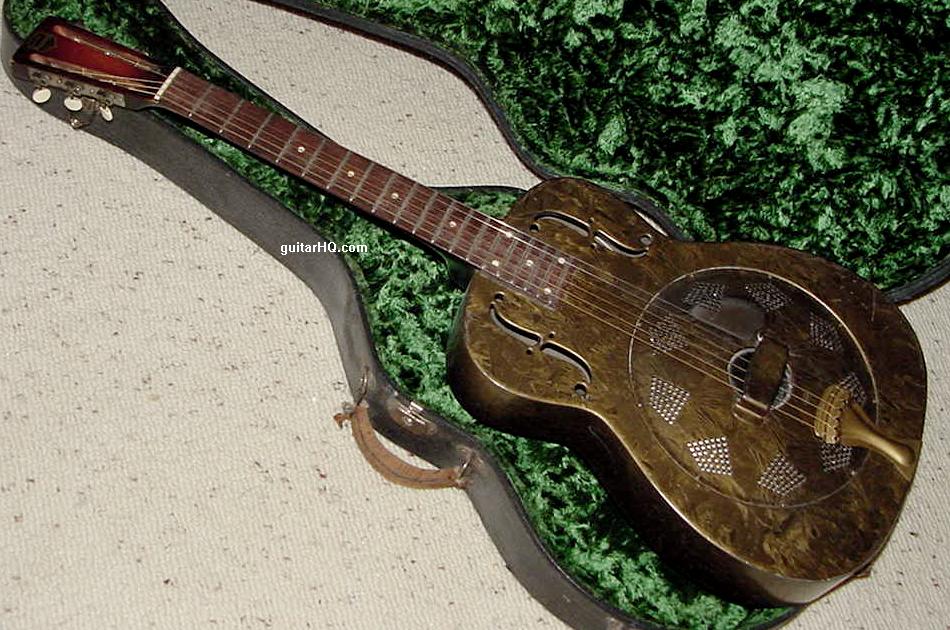Vintage Guitars Info's
Dobro Metal Body Resonator
Vintage Guitar Info.
As you can imagine, the higher the style number, the more the resonator is worth. This doesn’t mean the Style 1 is worthless though. A National Style 1 tricone from the late 1920s or 1930s is currently worth between $5,000 and $6,000 in excellent condition. Though there is a serial number inside the body there isn’t one on the neck / headstock. National Reso-Phonic Guitars is open and crafting instruments, current wait times for new instruments is 6 - 8 months. Quick View 'RAW' Series Instruments. Revolution® Biscuit Bridge Resonator Kit. Revolution® Biscuit Bridge Saddle. Revolution® Biscuit Bridge Base. NationalResophonicResoRocketWB20858.mp3 Description This 2016 WoodRocket from National Reso-Phonic is a modern version of the popular single cone resonator that combines the warmth of a 12-fret neck with a cutaway for access to those uppermost frets.
Dobro picture gallery
Contact the Vintage Guitar Info Guy1938 Dobro No.35 metalbody
- Introduction:
- 1928-1937 Vintage Dobro Serial Numbers (includes bothmetal and wood body resonator instruments)
- 1970-present OMI Dobro Serial Numbers (includes bothmetal and wood body resonator instruments)
- M-32 gold painted vintage resonator metalbody
- M-35 sunburst painted vintage resonator metalbody
- M-46 'Lumalite' silver painted vintage resonator metalbody
- M-47 'Lumalite' mahogany grain painted vintage resonator metalbody
- M-14 nickel plated vintage resonator metalbody
- M-15 nickel plated vintage engraved resonator metalbody
- M-16 nickel plated vintage engraved resonator metalbody
- M-62 'Spanish dancer' nickel plated vintage resonator metalbody
- M-65 'singing ladies' nickel plated vintage resonator metalbody
- Ukulele vintage resonators
1935 to 1940 Metal Body Resonator Vintage Model Info:
Painted Metal body Dobro Resonators:
Nickel Plated Metal body Dobro Resonators:
- The Resonator.
The Dobro is a single cone resonator guitar that is easily confused at firstglace with the single cone National guitars. But in fact, they are fundamentally different in construction and design. The Dobro resonator isdish-shaped, opposite of the volcano-shaped National resonator. The Dobrohas an eight legged bridge support (called a 'spider') that spans the dishand conducts the string vibrations (compared to National's biscuit system).
If it has a smooth edge, it's a reissue made from1970 or newer.
Left:1935-1940 No.32 with a gold 'frosted Duco' krinkle finish. Note the fiddle edge.
Right:1935-1940 No.62 Dobro with a fiddle edge.
- Metal Body Resonator Guitars.
Most Dobros have wooden bodies, but Dobro also made metalbody guitars from1935 to 1940 only. Regal (which was Dobro's exclusive licensee) also mademetal body resonator guitars with their brand name and also the 'Old Kraftman' name. Severalother resonator brand names were also used such as Ward, but these are in fact still Regal/Dobro made resonator guitars.All metalbody Regal/Dobros have 14 frets clear of the body.
The construction of the Regal/Dobro metalbody was quite different than National guitars. Regal/Dobro tops and backs were fastened to the sides with a unique methodthat required no soldering. The resulting lip around the edges gave riseto the name 'Violin Edge' or, 'Fiddle Edge' as it was known around the factory. This construction method was only used from 1935 to 1940. Alllater model metal Dobro's which were in production from the 1970 to thepresent are easily identifiable because they lack thisfiddle edge. Some of these models used a 'M-' prefix or 'M' suffix around the model number. Hawaiiansquare neck models used a 'P-' prefix or 'H' suffix.
Port holes versus f-holes on two metal body vintage 1935-1940 Dobro guitars.
Left: gold 'frosted Duco' No.32 with port holes.
Right: sunburst No.35 with f-holes.
- Port holes versus f-holes.
Also most Dobro metalbodies have window-like round soundholes in the upper body, except for (consistently) the No.35 which has segmented F-holes. Though some other models will also have segmented F-holes, most models withthe Dobro brand name have the round window soundholes. Segmented F-holesare seen more on Regal brand resonator instruments than Dobro.
Metal or wood body, Dobros with 'f' holes are considered less desirable than 'port' hole models.Dobro used f-holes on their less expensive models,and port holes on their mid to upper end models. This especially appliesto wood body Dobros. Metal body dobros this is not really an issue.
The tailpiece used on all 1935-1940 vintage
Dobro metal bodies.
- Metalbody Dobro Tailpieces.
The tailpiece used on 1935-1940 metal body vintage Dobro's is very unique.And it's very fragile. Often you see these broken where they wrap aroundthe fiddle edge of the body. Since no one has made a fiddle-end guitar since1940, replacements are very difficult to find.


National Resophonic Tricone

National Resophonic Tricone National Resophonic Guitars For Sale
Round versus Square Neck Models.
Roundneck metalbody vintage Regal/Dobros are more valuable than squareneck metalbodies. In woodbody Dobros, the opposite is true; squareneck woodbody Dobros are more valuable than roundneck woodbodies.
I collect just roundneck metalbody Regal/Dobros. They have a sweet tone with limited attack, but long decay (opposed to National's single cone sound of sharp attack, short decay). In this respect, a good metalbody Regal/Dobro sounds a lot like a tricone National.
Lucky for me, metalbody Regal/Dobros are not considered by the collectorcommunity to be as good or valuable as National metalbody guitars. This has kept the prices somewhat low compared to other vintage guitars.
Back to the Table of Contents
A Dobro peghead decals from the 1930's. The 'solid' peghead on
the right is from a (1938-1940) M-35 metal body.
Serial number on a 1936
M-35 metal body.
Dobro Serial Numbers
